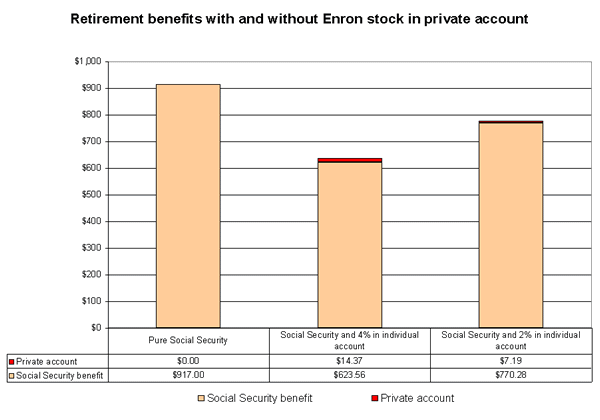A weekly presentation of downloadable charts and short analyses designed to graphically illustrate important economic issues. Updated every Wednesday.
Snapshot for January 30, 2002.
What if Enron workers had traded Social Security for stock?
With thousands of Enron workers having lost most of their retirement savings, policy makers should once again turn their focus to retirement income security. Recent history has proven again that the most secure form of retirement savings is Social Security. Nonetheless, a recent presidential commission proposed three options to allow workers to contribute between 2% and 4% of their payroll, or 16% and 32% of their contributions to Social Security, to private individual accounts.
To understand the risks associated with this proposal, consider the following hypothetical case in which a worker elected to invest part of her retirement in one of these individual accounts. Say, for instance, that a worker with average earnings started working in 1966 at age 30, later became employed at Enron when it was created in 1985, and eventually retired in 2001. Choosing not to receive all of her retirement benefits from Social Security, she instead diverts 2% or 4% of her earnings to a private account, reducing her Social Security benefits by either 16% or 32%. For argument’s sake, let’s also presume that, prior to 1985, the personal account was invested in an S&P 500 index, and then after 1985 in Enron stock.

By the end of 2001, this worker would have received $917 a month from Social Security if she had not elected to divert some money into one of these proposed individual accounts. If she chose to contribute 2% to an individual account, her Social Security benefit would have been reduced to $770 and her individual account would have provided only $7 more a month in retirement income. If she had invested the maximum of 4% in an individual account, her Social Security benefits would fall to $638 a month plus an additional $14 from her individual account. In the end, the individual account would have replaced less than 5% of the sacrificed Social Security benefits.
This week’s Snapshot by EPI economist Christian E. Weller.
Check out the archive for past Economic Snapshots.
